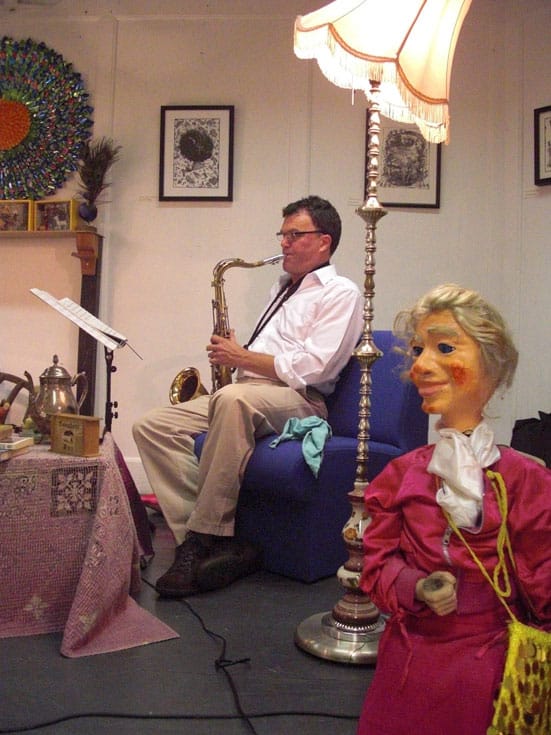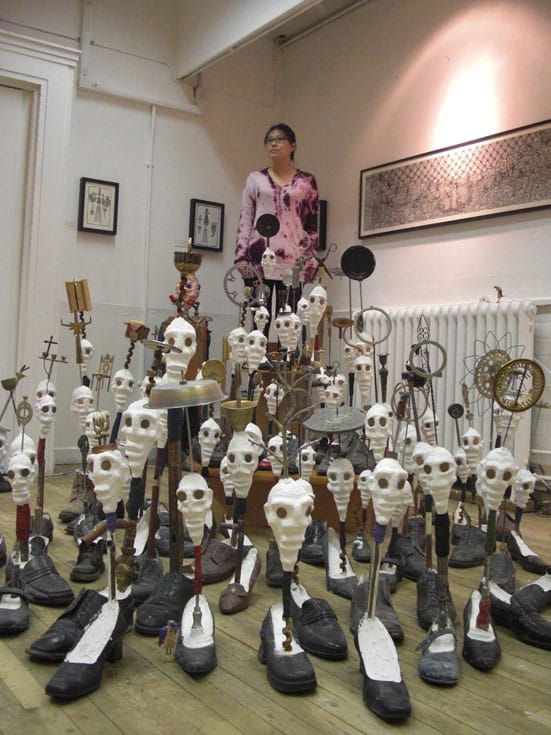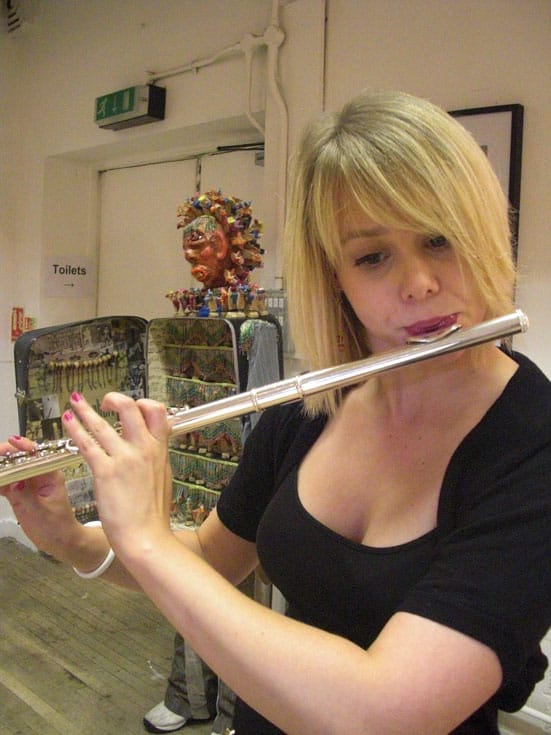26th August 2010 — 7th September 2010
Opening night 1: An Evening of Music for Solo Instruments, 26th August 2010 ING NIGHT 1: AN EVENING OF MUSIC FOR SOLO INSTRUMENTS. 26TH AUGUST 2010.
The Gallery, Stoke Newington Library
Should your mother, like mine, be a dab hand with the gouache and “shows” occasionally in library galleries you may consider that, while a laudable activity for septuagenarians, this may not be typical AV territory? This is, however, Stokie...
Festoon is a two week long small Arts Festival, principally conjured into existence by Kate Bradbury (visuals) and Mercedes Maresca (music) for the sheer joy of doing so. It's a classic example of how much can be achieved by maximizing apparently limited resources, to wit a library gallery space, and charming favours from friends; in Maresca's case the abilities of a highly talented selection of post-grad Goldsmith's musicians, choosing their own soloists' repertoire for the evening, this then being programmed by Maresca herself.
Entering the gallery space (a funky little whitewashed walled room) one is greeted, principally, by perhaps two dozen approximately life size figures all of whom, having converted suitcases for their central trunks', possess a disquieting resemblance in shape to a series of Wicker Men. The lids of the suitcases stand open, which is to say we are looking into the collective stomachs of this merry crew, displaying a peculiar variety of contents. Some contain collections of miniature dolls, others playing cards, tools, little books (a stomach library), bottles and bottle openers and (more frighteningly) assemblies of scissors and saws. Combined with the suitcase figures' colourful Papier Mache faces, appendages and the miscellany of abandoned household objects and furniture that litter the room the overall feel is that of a Voodoo shrine, made of everyday bits and bobs, simultaneously tacky and disturbing. Emphasising the oddly domestic aspect of the work is the presence of a louchely attired Saxophonist lounging in a low, period, armchair on the room's tiny stage area, diffidently puffing his way through a selection of 1930's music.
At a nod from Maresca the evening's seven solo performers take positions around the room, figures amongst the figures (as are we), holding their stations until the performance's conclusion. Being unapprised of the sequence of soloists we are thus, over the next 45 minutes, passively and neatly led through the entire installation space, albeit somewhat on tiptoe as the room contains the noisiest floor ever constructed.
Marilyn Wyers opens proceedings on a tatty looking but fine sounding upright with Messiaen's brief and elegant piano prelude “La Columbe”, a very early piece of surprising, sad charm considering the man's later “heavy organ” reputation. Rather sweetly, at this point, various denizens of the library proper begin to slip into the room looking slightly bemused but greatly entertained. Jennifer Brand's plangent, big toned clarinet takes over for Christian Wolffs' “Dark as a Dungeon”. A peculiar composer, Wolff, much lauded by Sonic Youth, this piece is a particular favourite of mine. Demanding adept usage of the entire range of the clarinet (a long 'un) it's a hard yet always rewarding listen; the last third containing some of the most remarkable, almost swinging, rhythmic shifts in the whole contemporary classical repertoire. As dark as its title (referencing the Merle Travis folk song about Kentucky coal miners) it's always struck me as an oddly life affirming piece.
The baton passes to Laura Jay's flute and Honegger's “Danse De La Cherve” an impressionistic work of almost contradictory moods. It rhythmically compliments the Wolff as she navigates between its smooth lyrical and playful, fast staccato sections, managing to conclude (smilingly) just as the only mobile ring tone of the night sounds out (at least it was in key).
Stuck in a corner, surrounded and seemingly trapped by skulls on shoe supports and highly reminiscent of Winnie in Samuel Beckett's “Happy Days” stands soprano Jacqueline Yu. Indeed the, brief, Saint Preux “Concerto Pour Une Voix” she gently murmurs with its weirdly conversational and faux cheerful atmosphere also seems reflective of Beckett's play. The mood of the music is now darkening perceptibly, moving from complex to disquieting and the intelligence of Maresca's sequencing is beginning to make itself fully felt. All of the pieces are complimentary to each other but a clear sense of direction is established, locking us into the more bizarre sensations engendered by the proximity of the musicians to the suitcase figures. This is further emphasised as the lights dim for Emanuel Lorien Spinelli's lengthy live electronics piece “Microcosm In A Small Box”, performed from the stage area (under the still benevolently indulgent gaze of the seated Saxophonist) by the composer himself and a motley, sinister, collection of miniature toys.
Punctuated by Mercedes Maresca's own punchy rendition of Andre Jolivert's flute piece “Accueillir les Negociateurs”, creative of more emotional unrest through its panic impulse laden runs, we return to Wyers' expressive piano for the same composers “Beaujolais”, wherein the sad, jerking movements of a little copper doll gifted to Jolivert by Edgard Varese become the writer's muse.
The sequencing of the pieces has provoked a palpable sense of musical tension and with Luciano Berio's “Sequenza VIII”, the evening's concluding piece, diminutive violinist Mizuka Yamamoto unintentionally but entirely appropriately “caps” and steals the show. Part of the Darmstadt school (Stockhausen, Boulez and the gang), Berio's compositions are inherently “difficult”. Being Italian, and something of a Futurist to boot, he inclined towards virtuosity thus rendering the “difficult” into the “near impossible”. Yamamoto, however, is up to the task. Her performance, for me and (I suspect) many others captured one of those “is this is as good as I think it is?” moments swiftly followed by an “Oh yes, it is!” moment. Much of the piece is designed to be played at maximum speed and explore the most extreme sound varieties of the violin; fingers, fundamentally, must fly! Showing superb command of her instrument Yamamoto negotiates her way through this not just with aplomb but with a breathtaking sense of excitement, indeed in the more heavily chorded sections she hacks her way through highly rhythmic, tightly chromatic motifs like a half demented hillbilly with an accidentally acquired education in Classical Music.
Sadly I was only able to attend this first of two evenings of musical performances and I'd like to have spent more time with the visuals. If I suggest that the musical aspect here contained slightly more profundity than the Installation that's no slight upon it, merely a reflection of the very high quality of the musical program and, particularly, the soloists themselves. All in all, a little gem!
Curators: Kate Bradbury, Mercedes Maresca
Visuals: Kate Bradbury, Sue Kreitzman, Oliver Sparks
Musicians: Brian Rodgers, Marilyn Wyers, Jennifer Brand, Laura Jay, Jacqueline Yu, Emanuel Lorien Spenelli, Mercedes Maresca, Mizuka Yamamoto
Keiron Phelan


